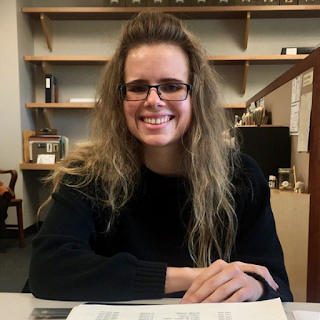For this week’s edition of “Holbrook’s Trunk,” we caught up with Heather to learn more about the upcoming workshop and about her work as an artist.
1. What are some of your favorite works at the Georgia Museum of Art?
“The Playground” tempera painting by Paul Cadmus is my absolute favorite. I love the grotesque look Cadmus gives his characters. Something about their rigid postures and caricatured physiques — wilted and gangly, round and protruding, beady-eyed, dog-eyed — reminds me of Byzantine and Romanesque figures. Like these medieval draughtsmen, Cadmus is more concerned with the spirit behind the corporeal vessel; the spirits he portrays aren't the austere, ethereal sort, but comic, lewd and humane. In “The Playground,” Cadmus’s invasive attention to texture, the infinitely gritty bricks, and the opalescent skin of the pale, butt-rubbing protagonist wraps Cadmus's imaginative take on human characters with uncanny tangibility.
 |
| Paul Cadmus, The Playground, 1948 |
For me, experiencing work in person is like an intimate conversation with a fellow artist. The indentations an artist makes with his or her pencil, the way paint absorbs or reflects light, the saturated, velvet surface of gouache or pastel, etc. do not translate through cellphone and computer screens. Apart from net art, or consciously digital media, which deftly navigates technology, physical artwork is much more eloquent in the flesh. Experiencing drawings, paintings or sculptures face-to-face hugely expands their vocabulary. The museum offers a guttural, communicative experience that reminds me why I make art.
3. What are some of the pieces from the museum’s collection that you have selected to show in the studio workshop “The Human Figure,” and why did you choose these?
A lot of work that I have chosen for us to examine at the Human Figure workshop is sketchy, simple and obviously hand-wrought. I want to embolden participants by making it evident that figure drawing is an instinctual, responsive ability accessible to everyone. As a young artist, I was hugely intimidated by the human figure. However, I was forced to create gesture drawings under a minute for a community college art class. These rapid gestures did not give me the time to convince myself that I could not draw people. Discovering that I could create a decent gesture emboldened me — I have been drawing and developing my understanding for the human figure ever since.
With this personal experience in mind, I decided that we would study and emulate phenomena such as Alberto Giacometti’s searching lines in his lithographs “Annete” and “Derriere Le Mirior: Seated Woman.” Giacometti made mistake after mistake when studying his sitter, however, he eventually carved out a semblance of the person with his persistent marks. We will also be looking at figural studies by Richard Diebenkorn, Rodin and Lamar Dodd, along with Kathe Kollwitz’s tremendously emotive, yet palpably drawn prints.
4. Is there something you are currently working on or are excited about starting that you can tell us about?
 |
| Studio instructor Heather Foster visiting the offices of the Georgia Museum of Art |
When making my own “Vanishing Mountains” drawings, I like to think that I’m writing too. I have confined myself to materials that are prescribed for creating documents, not art: ballpoint pens and printer paper. For me, using pen and paper activates a part of my mind that jots down the vanishing fragments of my dreams just when I’ve woken up. As with the Chinese scholar painters, my use of simpler material closes the gap between the mental and drawn image. My subject matter draws from my experiences at the Grand Tetons in Wyoming. Thanks to the experience volunteering as a docent at the Georgia Museum of Art, I was privileged to intern at the National Museum of Wildlife Art in Jackson Hole, Wyoming.
5. What do you read, listen to, or look at to fuel your work?
When creating, I love to listen to audiobooks and lectures on YouTube. The last book that I’ve listened to was “The Name of the Rose” by Umberto Eco. I am currently listening to World Science Festival panels — topics include black holes, holograms and multiverses.
6. What advice or words of wisdom have influenced you as an artist?
Atlanta-based artist Eric Mac told a group of us UGA artists to “keep your hands busy” — that’s been my mantra for now!
“Studio Workshop: The Human Figure” runs Thursdays, May 5 through 26, from 6:30 to 8:30 p.m. The cost of the course is a $15 materials fee, which covers all necessary supplies for the four sessions. Space is limited, call 706.542.8863 or email callan@uga.edu to reserve a spot.

No comments:
Post a Comment